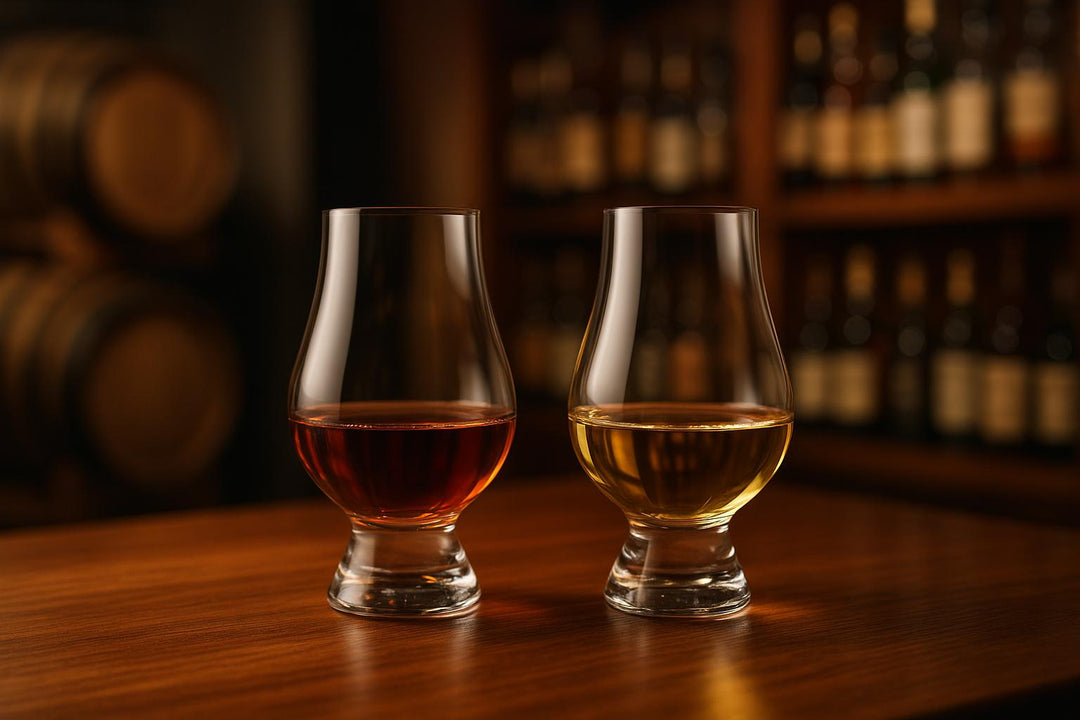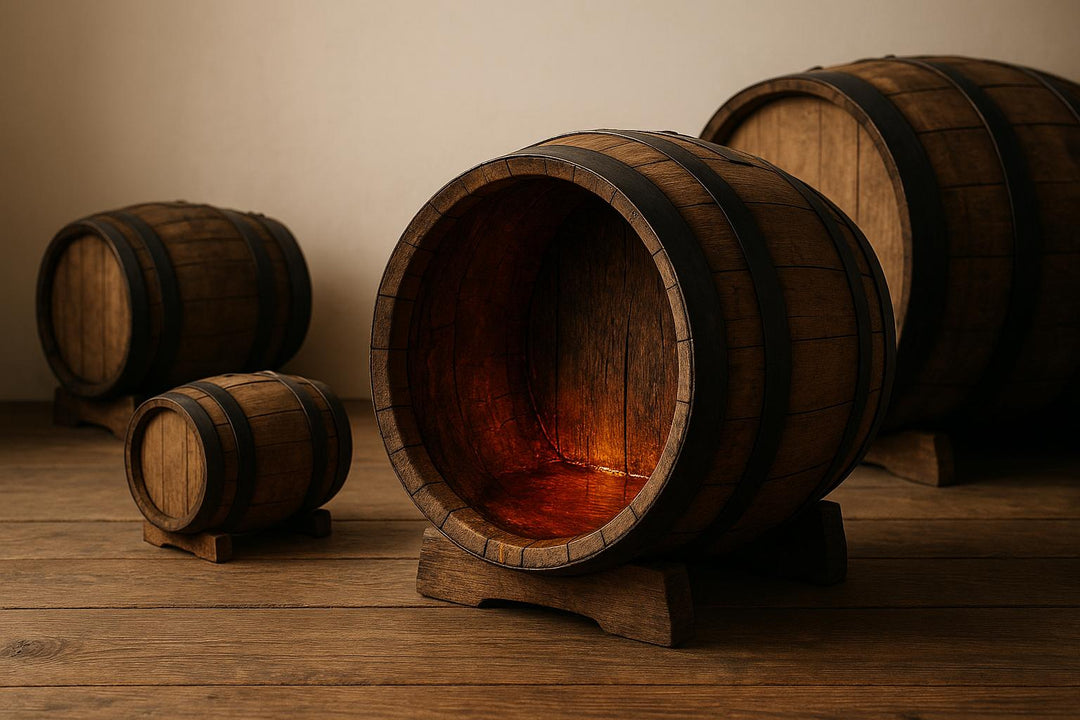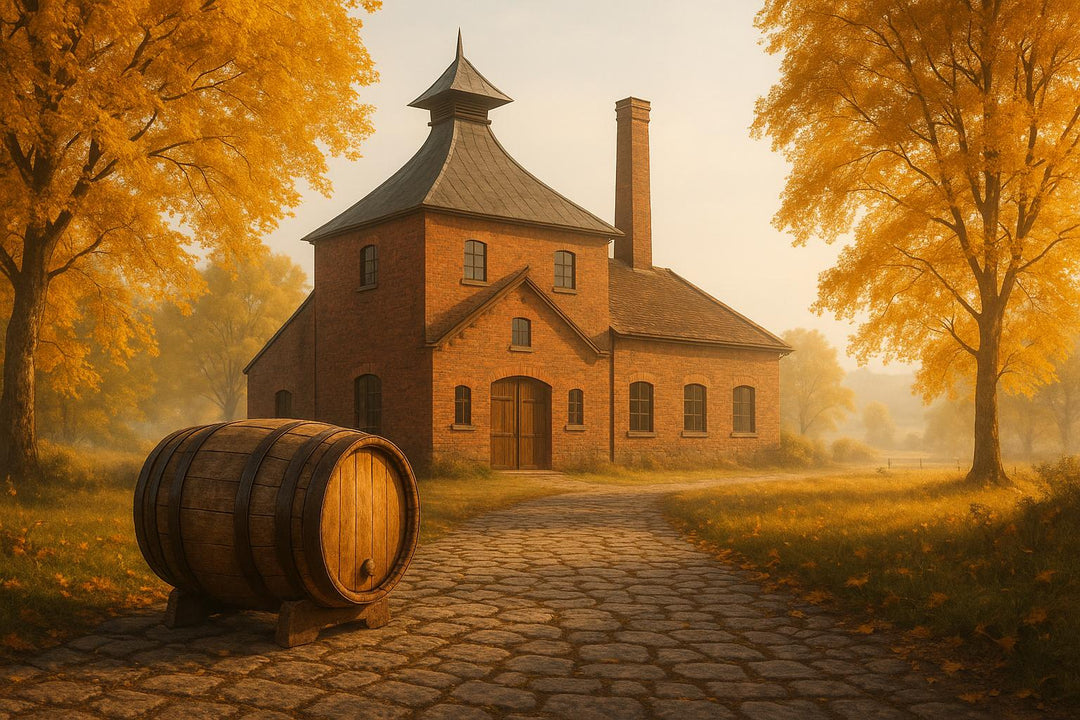Barley is the backbone of whisky production, defining its flavour and character. High-quality barley contributes to sweetness, maltiness, and complexity, while poor-quality barley can lead to off-flavours and lower yields. Key factors that influence barley's impact on whisky include:
- Moisture Content: Barley must be dried below 14% to prevent spoilage and ensure proper fermentation. Excess moisture can lead to mould and flavour issues.
- Protein Levels: Balanced protein (10-12%) ensures good alcohol yields and supports yeast activity. Too much or too little protein reduces efficiency and flavour.
- Storage and Freshness: Proper storage at 12% moisture preserves barley's enzymatic activity and starch content, which are essential for flavour during fermentation.
Barley variety and its growing conditions also play a role. Experiments show that where barley is grown (terroir) can significantly influence whisky aroma and flavour, sometimes more than the barley variety itself. Distilleries like Bruichladdich and Waterford are exploring this connection to craft distinct flavour profiles.
Maintaining barley quality involves rigorous testing, sensory evaluation, and traceability, ensuring consistency and delivering the unique flavours whisky lovers enjoy. Barley isn't just an ingredient - it's the heart of every dram.
Exploring old barley varieties used in making whiskey in Ireland
Key Barley Quality Factors That Affect Flavour
To understand what makes barley ideal for whisky production, you need to delve into three essential factors that shape the spirit's character. Each plays a unique role in influencing the final flavour profile of the whisky.
Moisture Content
Moisture content is one of the most critical aspects of barley quality, directly affecting both storage and whisky flavour. When barley is harvested, its moisture level is typically around 15% or higher[4]. This is too high for proper storage or whisky production, so the barley must be dried to below 14%[4].
Maintaining moisture levels below this threshold is vital. If barley is stored with too much moisture, it can deteriorate, impacting both yield and flavour. As Curraghmore Whiskey explains:
"Well, if you store barley with higher moisture content, you run the risk of barley deterioration. This will negatively impact the yield and quality at distillation."[4]
Excessive moisture can cause the grain to respire, depleting the reserves needed for germination. It also creates the perfect conditions for mould and disease, which can introduce unpleasant flavours[4]. On the flip side, overdrying wastes energy and reduces alcohol yields[4]. To avoid these issues, distilleries rely on specialised tools to monitor moisture levels, ensuring they stay just below 14%[4].
Protein Levels
Protein content in barley is another key factor that influences whisky flavour and yield. A high protein level is generally undesirable because it lowers the carbohydrate content, which is crucial for alcohol production. As industry experts explain:
"In general, a high protein content is undesirable, as there is a strong correlation between a high protein content and a low carbohydrate content, leading to a low extract yield. Basically the higher the protein levels, the lower the carbohydrate levels – which means the lower the alcohol levels."[4]
However, having too little protein isn't ideal either. Low protein levels can lead to inadequate nutrients for yeast during fermentation and reduced enzymatic activity, which results in fewer fermentable sugars and lower extract yields[4]. Striking the right balance - typically between 10% and 12% protein - is key to ensuring both a good yield and proper flavour development[4].
Modern barley varieties with optimised protein levels can produce over 400 litres of alcohol at 100% ABV per tonne. In contrast, heritage varieties like Golden Promise yield around 380 litres[6]. This difference highlights how protein content affects both efficiency and flavour.
Freshness and Storage
Barley freshness and proper storage are crucial for preserving its flavour potential. Fresh barley retains its enzymatic activity and starch content, both of which are essential for creating the sugars needed during fermentation[7]. As one expert succinctly puts it:
"When you buy a bottle of single malt Scotch whisky you are buying a bottle of barley."[8]
Storing barley at an ideal moisture level of around 12% ensures stability and helps preserve its flavour-contributing properties[8]. Poor storage conditions can lead to deterioration, introducing off-flavours that linger through distillation and maturation. Quality distillers aim for barley that can yield between 350 and 420 litres of alcohol per tonne[8]. Achieving this requires careful handling from harvest to mashing to maintain freshness.
Ultimately, the importance of barley in whisky production cannot be overstated. As one industry professional puts it:
"Without barley, none of the flavours of single malt whisky are possible."[8]
Barley Variety and Origin
The role of barley variety in shaping whisky flavour has long been debated. Some experts argue that its impact on the new make spirit is minimal. Vic Cameron, a former Diageo representative, shared this perspective:
"In my opinion, barley variety has very little or no effect on new make spirit character."[3]
This view reflects the industry's traditional focus on consistency and efficiency, where barley varieties are typically bred for better disease resistance and higher yields, rather than flavour enhancement[7][9]. However, this mindset is being challenged by a growing number of distilleries. For instance, Bruichladdich has been experimenting with barley, distilling spirit from 12 different varieties and planning to expand further[7]. Their work suggests otherwise:
"Straight from the still, at zero age, even before maturation, whiskies distilled from different barley varieties are identifiable one from the other. Some of this variation is immediately obvious, even to the novice."[7]
Barley varieties often evolve quickly, prompting some distilleries to return to traditional, locally sourced strains to achieve distinctive flavour profiles. This approach mirrors brewing practices, where malted barley is known to play a key role in defining beer styles like porters, stouts, and amber ales[2]. The industry is increasingly moving away from treating barley as a commodity focused on yield and uniformity, instead exploring its potential for flavour. Historically, before World War II, much of the barley used in whisky production was sourced locally[7].
This shift naturally leads to discussions about how regional factors influence barley’s contribution to whisky flavour.
Terroir and Regional Influences
The concept of terroir - encompassing soil, climate, and topography - has a profound effect on whisky flavour. Studies indicate that growing conditions often have a greater influence on a spirit’s aroma than the barley variety itself[10].
Research conducted by Oregon State University and Waterford Distillery in 2017 and 2018 supports this. Two widely used barley varieties, Olympus and Laureate, were cultivated in two distinct Irish environments: Athy (inland) and Bunclody (coastal). The barley was harvested, malted, and distilled under identical conditions. The findings revealed that the growing environment had a more significant impact on whisky aroma than the barley variety[10].
Dustin Herb, a faculty member in Crop and Soil Science at Oregon State University, explained:
"Terroir is increasingly being used to differentiate and market agricultural products, most commonly wine, as consumers grow more interested in the origins of their food. Understanding terroir is something that involves a lot of research, a lot of time and a lot of dedication. Our research shows that environmental conditions in which the barley is grown have a significant impact."[10]
Further sensory analysis confirmed these findings. Barley grown in Athy produced whisky with richer fruit and malt notes, while barley from Bunclody brought out green, grassy, and mineral characteristics[11]. These distinct flavour profiles remained consistent throughout the production process, from field to glass. Waterford Distillery has embraced terroir, sourcing barley from over 100 different regions to highlight its impact[12]. As Mark Reynier, CEO of Waterford, stated:
"We know categorically that terroir does influence flavour in malt whisky, as flavour compounds formed in barley are also present in the distilled spirit."[12]
The research also revealed a "vintage" effect - flavour variations that ranged from fruity and floral to malty and herbal, depending on yearly changes in soil nutrients, weather, and farming practices[11].
These findings underscore the complex interplay between barley, environment, and whisky flavour, echoing the craft-driven ethos celebrated by The Really Good Whisky Company.
sbb-itb-128d6c1
Barley Quality Control in Whisky Production
Maintaining consistent barley quality is no small feat - it requires a detailed and diligent approach. Distilleries depend on a combination of laboratory testing, sensory evaluations, and sophisticated traceability systems to ensure the high standards that premium whisky demands. These methods work together to uphold the integrity of the whisky-making process.
Laboratory Testing for Quality
Modern whisky production leans heavily on laboratory testing to evaluate barley quality at every stage. According to the Montana State University Barley Breeding Program:
"Tight specifications of barley and malt are established to ensure good final product quality." [13]
The testing process begins at the malting facility. For instance, Aberdeen Grain employs advanced tools like Infratec analysis to measure moisture and nitrogen levels. They also conduct screenings to assess grain size and remove impurities, and Rapid Staining Tetrazolium tests to check germination. While in storage, additional tests such as Hydrogen Peroxide assays and measurements of germinative energy and water sensitivity are used to monitor dormancy and ensure barley is dried to an optimal moisture content of 12–14%, preventing degradation [14].
Protein content is another critical factor, with the ideal range for malting barley being 10–12%. Curraghmore Whiskey highlights this balance:
"The ideal protein content for malting barley resides between 10 and 12%, and too high or low a protein content can negatively affect malting quality and, therefore, distilling quality and yield." [4]
To support these rigorous standards, professional testing services offer tailored analysis packages. For example, a Grain Quality Testing Selection Package is priced at £85 per sample, while more specific tests like Grain Moisture & Protein Content analysis cost £15 per sample, and Germination Characteristics tests are £30 per sample [13]. However, laboratory testing is only part of the picture - sensory evaluation adds another layer of precision.
Sensory Evaluation Techniques
While lab tests provide hard data, sensory evaluation captures the subtleties of flavour that machines can’t fully quantify. These evaluations ensure the whisky’s flavour profile remains consistent. Advanced tools like electronic nose technology are now being used to predict barley’s total phenolic content with over 89% accuracy when compared to traditional measurements [15]. When combined with traditional sensory panels, these tools help distilleries fine-tune their flavour profiles and maintain quality at every stage [16].
Traceability of Barley
Traceability is the backbone of quality assurance in whisky production. By tracking barley from the field to the bottle, distilleries can quickly pinpoint the source of any inconsistencies, limit the scope of recalls, and continually refine their processes. To manage this complexity, many distilleries use advanced systems like barcode and RFID technology, along with standard operating procedures and regular audits, to maintain precise, real-time records [17][18].
This meticulous documentation does more than safeguard quality - it also reinforces the story of the whisky’s origins and craftsmanship, which is a key factor in building consumer trust. For example, Glen Scotia processes 28 tonnes of Concerto malted barley every week into their malt bins, a process that demands detailed record-keeping to uphold their exacting standards [19].
How Barley Quality Shapes Whisky Flavour
Barley isn't just a key ingredient in whisky; it plays a defining role in shaping the drink's flavour. Once its quality is confirmed through rigorous testing and traceability, the natural characteristics of barley come into play. Factors like moisture levels, protein content, and storage conditions are meticulously controlled, and these elements directly influence the whisky's flavour profile.
The Final Impact on Flavour
High-quality barley contributes to a spectrum of flavour notes, including malty, creamy, woody, sweet, fruity, smoky, spicy, and floral tones [21]. On a more specific level, it can evoke flavours such as malted milk biscuits, almonds, hazelnuts, and toast [5].
Distilleries often highlight how different barley varieties create distinct flavour profiles. These variations affect sweetness, maltiness, mouthfeel, and even fermentation characteristics [1]. For instance, fresh, locally sourced barley can introduce flavours ranging from porridge-like notes and creamy biscuits to sugar puff sweetness and the earthy essence of fresh barley fields [7].
As Matt Hofmann, Westland's master distiller, puts it:
"I have tasted barley's flavor impact, and it is significant." [2]
These flavour nuances give whisky its unique character, even before it undergoes the maturation process.
Understanding Whisky Through Its Ingredients
The connection between barley quality and whisky flavour is so strong that experts argue these differences are noticeable even before the whisky has aged. Bruichladdich Distillery supports this view:
"Straight from the still, at zero age, even in this nascent state before the whisky has had a chance to mature, whiskies distilled from different barley varieties are identifiable one from the other. Some of this variation is immediately obvious, even to the novice." [7]
This means that whether you're a seasoned whisky enthusiast or just starting your journey, you can appreciate how barley quality influences the drink. For those venturing into premium or rare whiskies, understanding the role of barley adds a deeper layer to the tasting experience. The Really Good Whisky Company offers a curated selection of Scotch, Japanese, American, and world whiskies, showcasing how different barley varieties contribute to diverse and exciting flavour profiles.
Matt Hofmann sums it up perfectly:
"Ultimately it all has to taste good. That's the most important thing. We're doing all of this with the eye of ultimately making better products." [20]
This philosophy highlights why barley quality is so crucial - it’s not just about technical details; it’s about crafting whisky that delivers unforgettable flavour in every sip.
FAQs
How does barley's moisture content influence whisky flavour?
The moisture level in barley is a key factor in determining the flavour profile of whisky. For optimal results, it needs to stay below 14%. If the moisture content exceeds this threshold, it can lead to problems like spoilage, mould, or even premature sprouting. These issues not only compromise the quality of the barley but can also affect the whisky’s flavour and production yield.
Keeping the moisture content in check ensures the barley is in the best possible state for malting - a crucial step that helps shape the unique character and taste of the whisky.
How does the protein content in barley influence whisky flavour and production?
The protein content in barley is a crucial factor in shaping both the flavour and the efficiency of whisky production. The sweet spot for protein levels is typically 10–12%, as this strikes the right balance between flavour enhancement and malting performance.
Protein plays a key role in enzyme activity during malting, which is vital for breaking down starches into fermentable sugars. When the protein levels are just right, the fermentation process runs more smoothly, resulting in a whisky with greater flavour complexity and improved distillation efficiency. While slightly higher protein can lend richness and a creamy texture to the whisky, too much protein can disrupt the malting process and lower the overall yield.
How does terroir influence whisky flavour compared to the barley variety?
The concept of terroir is pivotal in defining a whisky's flavour, with factors like soil, climate, and water leaving their mark. These environmental elements shape the barley's growth, influencing its nutritional makeup and, ultimately, its taste.
The type of barley used is equally important. Different barley varieties affect how the grain performs during malting and distillation, which further refines the whisky's character. When combined, terroir and barley variety create the distinctive and layered flavours that make each whisky unique.






Leave a comment